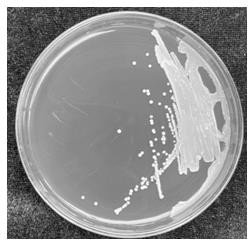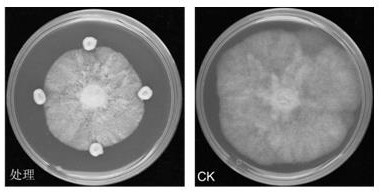Hansenula anomala MP261 capable of inhibiting phytopathogen and application of hansenula anomala MP261
A technology of Hansenula sporogenes and MP261, which is applied in the field of microorganisms, can solve problems such as environmental pollution and drug residues, and achieve broad-spectrum antibacterial properties and good market application prospects
- Summary
- Abstract
- Description
- Claims
- Application Information
AI Technical Summary
Problems solved by technology
Method used
Image
Examples
Embodiment 1
[0041] 1. Isolation and screening of strains
[0042] In September 2019, samples of leaves, roots and petals of different plants were collected in Laoshan, Qingdao, and the lesions and necrotic parts were removed and cut into pieces for use. After cutting the samples, they were placed in YPD liquid medium containing a final concentration of 0.01% chloramphenicol. (1% YeastExtract, 2% Peptone, 2% Dextrose), 28 °C, 180 rpm shaking culture for 2 days; take the above culture medium diluted with sterile water, spread on YPD plate for separation, and initially observe strains after 28 °C culture for 2 days. Pick a suitable single colony for streak separation again to obtain a pure cultured strain.
[0043] Pick a single colony of strains, use the plate confrontation growth method to inoculate a single colony and a variety of plant pathogenic bacteria on a potato dextrose agar (PDA) plate (200 grams of potato, wash and cut into pieces, add appropriate water and boil for 20 to 30 minu...
Embodiment 2
[0066] Dip the Ralstonia solanacearum solution with a sterile cotton swab, spread it on the surface of the plate, and then inoculate the MP261 strain in the center of the plate. The petri dish was placed upside down in an incubator (26-28°C) for 1-2 days, and the bacteriostatic effect of MP261 strain on Ralstonia solanacearum was determined.
[0067] Test results such as Figure 14 As shown in Table 2, it was found that an obvious inhibition zone appeared around the colony of the MP261 strain, indicating that the MP261 strain also had a significant inhibitory effect on the growth of Ralstonia solanacearum.
[0068] Table 2. Inhibitory effect of MP261 strain on R. solanacearum
[0069]
Embodiment 3
[0071] The volatile gas generated by MP261 was collected by a 20ml headspace vial, and the components of the volatile gas were tested by solid phase extraction and gas-mass spectrometry GC-MS instruments. Solid phase extraction: SIGMA-ALDRICH 57329-U (DVB / CAR / FDMS); GC-MS instrument: TSQ series 8000; chromatographic column: Thermo TG-5SILMS, capillary column (30m×0.25mm×0.25μm). Headspace extraction was performed for 1 hour at 40°C. The injection temperature was 250°C, the carrier gas: He, and the flow rate was 1.3 ml / min. Column temperature heating program: hold at 40 °C for 2 min, then increase to 100 at 3 °C / min, hold for 0.1 min; then increase to 240 °C at 20 °C / min, hold for 5 min. Chromatograms were recorded in full scan mode, m / z 40-400 amu, and the ion source temperature was set to 230 °C. The obtained substances were automatically searched by computer and matched with the NIST Library.
[0072] The experimental results show that MP261 can produce a variety of volat...
PUM
 Login to View More
Login to View More Abstract
Description
Claims
Application Information
 Login to View More
Login to View More - R&D
- Intellectual Property
- Life Sciences
- Materials
- Tech Scout
- Unparalleled Data Quality
- Higher Quality Content
- 60% Fewer Hallucinations
Browse by: Latest US Patents, China's latest patents, Technical Efficacy Thesaurus, Application Domain, Technology Topic, Popular Technical Reports.
© 2025 PatSnap. All rights reserved.Legal|Privacy policy|Modern Slavery Act Transparency Statement|Sitemap|About US| Contact US: help@patsnap.com



